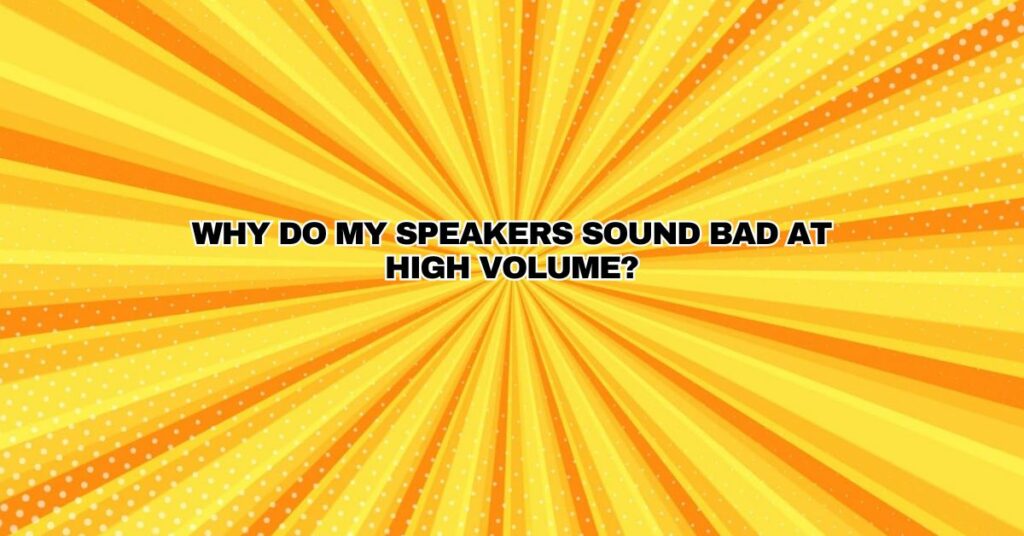In the realm of audio systems, the experience of playing music or audio at high volumes is both thrilling and perplexing. The phenomenon of speakers sounding bad at high volume levels is a concern often faced by audio enthusiasts and professionals. In this comprehensive article, we embark on a journey to understand the complexities of this issue, exploring the reasons behind why speakers can sound subpar at high volumes and how to mitigate these problems.
Table of Contents:
- Introduction: The Quest for High-Volume Euphoria
- The Allure of High-Volume Audio
- The Challenge of Quality at High Volumes
- The Anatomy of Sound Reproduction
- The Role of Speakers
- The Impact of Signal Amplification
- Challenges at High Volume
- Why Speakers Sound Bad at High Volume
- Distortion and Its Manifestations
- Mechanical and Thermal Limitations
- Cabinet Resonance and Vibration
- Understanding Speaker Distortion
- Types of Distortion
- Harmonic Distortion
- Intermodulation Distortion
- Managing Distortion at High Volume
- Selecting High-Quality Speakers
- Amplifier Power and Sensitivity
- Acoustic Treatments
- Subjective Sound Perception
- Listening Preferences and Expectations
- Musical Genres and Volume Considerations
- Room Acoustics and Speaker Placement
- Debunking Myths and Misconceptions
- The “Louder Is Better” Fallacy
- Achieving Clarity at High Volume
- Making Informed Choices: Optimal High-Volume Audio
- System Design and Components
- Speaker and Amplifier Matching
- Acoustic Improvements
- Conclusion: Striking the Right Balance
- The Quest for Sonic Excellence
- Enjoying High-Volume Sound
Chapter 1: Introduction: The Quest for High-Volume Euphoria
This chapter introduces the allure of high-volume audio experiences and outlines the challenge of maintaining quality at elevated volume levels.
Chapter 2: The Anatomy of Sound Reproduction
Readers will gain an understanding of the role of speakers, the impact of signal amplification, and the unique challenges that arise when pushing speakers to high volumes.
Chapter 3: Why Speakers Sound Bad at High Volume
This section explores the reasons behind why speakers may sound bad at high volume levels, delving into concepts like distortion, mechanical and thermal limitations, and cabinet resonance.
Chapter 4: Understanding Speaker Distortion
The chapter provides a detailed explanation of speaker distortion, including its various types, such as harmonic and intermodulation distortion.
Chapter 5: Managing Distortion at High Volume
Readers will learn about strategies for managing distortion at high volume, including the selection of high-quality speakers, considerations of amplifier power and sensitivity, and the role of acoustic treatments.
Chapter 6: Subjective Sound Perception
This section discusses the subjectivity of sound perception, considering individual listening preferences, musical genres, volume considerations, and the influence of room acoustics and speaker placement.
Chapter 7: Debunking Myths and Misconceptions
Common myths and misconceptions surrounding high-volume audio are addressed, challenging the belief that louder is always better and emphasizing the pursuit of clarity at high volumes.
Chapter 8: Making Informed Choices: Optimal High-Volume Audio
Practical advice is offered on making informed choices to achieve optimal high-volume audio, focusing on system design and components, speaker and amplifier matching, and acoustic improvements.
Chapter 9: Conclusion: Striking the Right Balance
The conclusion summarizes the key takeaways, emphasizing the quest for sonic excellence and the enjoyment of high-volume sound that strikes the right balance between volume and quality.
Conclusion: Striking the Right Balance
In the world of audio systems, the pursuit of high-volume audio experiences is a thrilling endeavor, yet it comes with its own set of challenges, including the issue of speakers sounding subpar at elevated volumes. This comprehensive exploration has unveiled the reasons behind this problem and provided insights into how to mitigate it.
Speakers are central to sound reproduction, but at high volumes, they face unique challenges. Distortion, both harmonic and intermodulation, is a primary concern, resulting from the mechanical and thermal limitations of speaker components and the resonance and vibrations of speaker cabinets.
Managing distortion at high volume requires a thoughtful approach. Selecting high-quality speakers that are capable of handling high volumes is essential. Matching amplifiers to speakers based on power and sensitivity is crucial. Additionally, implementing acoustic treatments in the listening environment can further improve sound quality.
Sound perception is highly subjective, influenced by individual listening preferences, musical genres, and the specific volume levels. It’s essential to debunk the myth that louder is always better and prioritize achieving clarity and quality at high volumes.
Making informed choices involves careful consideration of system design and components, matching speakers and amplifiers, and implementing acoustic improvements in the listening space. Striking the right balance between volume and quality is the key to enjoying high-volume sound while pursuing sonic excellence.


